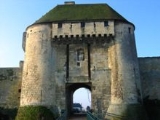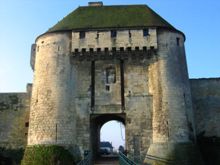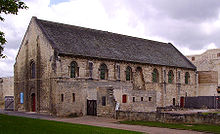
Château de Caen
Encyclopedia
The Château de Caen is a castle in the French town of Caen
in the Calvados
département (Basse-Normandie
). It has been officially classed as a Monument historique
since 1886.

, who successfully conquered England
in 1066. His son Henry I
then built the Saint Georges church, a keep (1123) and a large hall for the Duke Court
At Christmas 1182 a royal court celebration for Christmas in the aula
of Caen Castle brought together Henry II
and his sons, Richard the Lionheart
and John Lackland
, receiving more than a thousand knights.
Caen Castle, along with all of Normandy, was handed over to the French Crown in 1204. Philip II
reinforced the fortification
s.
The castle saw several engagements during the Hundred Years' War
(1346, 1417, 1450). The keep was pulled down in 1793 during the French Revolution
, by order of the National Convention
.
The castle, which was used as a barracks during World War II
, was bombed in 1944 and seriously damaged.
In 1946, Michel de Boüard, an archeologist from Caen decided to start excavations in the area of the castle to bring to the light medieval traces. The musée des Beaux-Arts
, which was installed in 1967, opened in 1971.
strategy and policy.
 Today, the castle serves as a museum that houses
Today, the castle serves as a museum that houses
The keep
, now razed, had a large square section with round towers at each corner. As the castle, it was also surrounded by a moat
.
The top of the rampart
s offers a splendid view of Caen. Some parts of the curtain walls were built during the 12th century, most of them date from the 15th century.
The castle has two doors: the porte sur la ville (door to the town) and the porte des champs (door to the fields); they are reinforced by two barbican
s.

(consolidation, opening of arrow slits walled during the 19th century)
. 6,000 m³ of earth are being removed, in order to give a better view of the north-west wall of the 12th century. This operation has revealed the cellar of a private house of the 15th century which still has its firehouse, a powder magazine and two walls of a forge of the 14th century. Traces of the stables have also been found.
The base of the keep has been cleared, and people are still working on excavations around it.
Caen
Caen is a commune in northwestern France. It is the prefecture of the Calvados department and the capital of the Basse-Normandie region. It is located inland from the English Channel....
in the Calvados
Calvados
The French department of Calvados is part of the region of Basse-Normandie in Normandy. It takes its name from a cluster of rocks off the English Channel coast...
département (Basse-Normandie
Basse-Normandie
Lower Normandy is an administrative region of France. It was created in 1956, when the Normandy region was divided into Lower Normandy and Upper Normandy...
). It has been officially classed as a Monument historique
Monument historique
A monument historique is a National Heritage Site of France. It also refers to a state procedure in France by which national heritage protection is extended to a building or a specific part of a building, a collection of buildings, or gardens, bridges, and other structures, because of their...
since 1886.

History
The castle was built circa 1060 by William the ConquerorWilliam I of England
William I , also known as William the Conqueror , was the first Norman King of England from Christmas 1066 until his death. He was also Duke of Normandy from 3 July 1035 until his death, under the name William II...
, who successfully conquered England
Norman conquest of England
The Norman conquest of England began on 28 September 1066 with the invasion of England by William, Duke of Normandy. William became known as William the Conqueror after his victory at the Battle of Hastings on 14 October 1066, defeating King Harold II of England...
in 1066. His son Henry I
Henry I of England
Henry I was the fourth son of William I of England. He succeeded his elder brother William II as King of England in 1100 and defeated his eldest brother, Robert Curthose, to become Duke of Normandy in 1106...
then built the Saint Georges church, a keep (1123) and a large hall for the Duke Court
At Christmas 1182 a royal court celebration for Christmas in the aula
Aula
Aula may refer to:*Atrium *Avola, a city in Sicily *Aula, Eritrea, a village in western Eritrea*Ultralight aircraft , Advanced ultra-light aeroplane...
of Caen Castle brought together Henry II
Henry II of England
Henry II ruled as King of England , Count of Anjou, Count of Maine, Duke of Normandy, Duke of Aquitaine, Duke of Gascony, Count of Nantes, Lord of Ireland and, at various times, controlled parts of Wales, Scotland and western France. Henry, the great-grandson of William the Conqueror, was the...
and his sons, Richard the Lionheart
Richard I of England
Richard I was King of England from 6 July 1189 until his death. He also ruled as Duke of Normandy, Duke of Aquitaine, Duke of Gascony, Lord of Cyprus, Count of Anjou, Count of Maine, Count of Nantes, and Overlord of Brittany at various times during the same period...
and John Lackland
John of England
John , also known as John Lackland , was King of England from 6 April 1199 until his death...
, receiving more than a thousand knights.
Caen Castle, along with all of Normandy, was handed over to the French Crown in 1204. Philip II
Philip II of France
Philip II Augustus was the King of France from 1180 until his death. A member of the House of Capet, Philip Augustus was born at Gonesse in the Val-d'Oise, the son of Louis VII and his third wife, Adela of Champagne...
reinforced the fortification
Fortification
Fortifications are military constructions and buildings designed for defence in warfare and military bases. Humans have constructed defensive works for many thousands of years, in a variety of increasingly complex designs...
s.
The castle saw several engagements during the Hundred Years' War
Hundred Years' War
The Hundred Years' War was a series of separate wars waged from 1337 to 1453 by the House of Valois and the House of Plantagenet, also known as the House of Anjou, for the French throne, which had become vacant upon the extinction of the senior Capetian line of French kings...
(1346, 1417, 1450). The keep was pulled down in 1793 during the French Revolution
French Revolution
The French Revolution , sometimes distinguished as the 'Great French Revolution' , was a period of radical social and political upheaval in France and Europe. The absolute monarchy that had ruled France for centuries collapsed in three years...
, by order of the National Convention
National Convention
During the French Revolution, the National Convention or Convention, in France, comprised the constitutional and legislative assembly which sat from 20 September 1792 to 26 October 1795 . It held executive power in France during the first years of the French First Republic...
.
The castle, which was used as a barracks during World War II
World War II
World War II, or the Second World War , was a global conflict lasting from 1939 to 1945, involving most of the world's nations—including all of the great powers—eventually forming two opposing military alliances: the Allies and the Axis...
, was bombed in 1944 and seriously damaged.
In 1946, Michel de Boüard, an archeologist from Caen decided to start excavations in the area of the castle to bring to the light medieval traces. The musée des Beaux-Arts
Musée des Beaux-Arts de Caen
The Musée des Beaux-Arts de Caen is a fine arts museum in the French city of Caen, founded at the start of the 19th century and rebuilt in 1971 within the ducal château.-Opening :...
, which was installed in 1967, opened in 1971.
Structure
The castle was constructed on a hillock and is now in the middle of the city. With an area of 5.5 hectares, it is one of the largest castles in Western Europe. It remained an essential feature of NormanNorman dynasty
Norman dynasty is the usual designation for the family that were the Dukes of Normandy and the English monarchs which immediately followed the Norman conquest and lasted until the Plantagenet dynasty came to power in 1154. It included Rollo and his descendants, and from William the Conqueror and...
strategy and policy.

- the Musée des Beaux-Arts de Caen (Museum of Fine Arts of Caen)
- the Musée de Normandie (Museum of Normandy) along with many periodical exhibitions about arts and history, in the castle residence;
- Saint Georges church;
- the Échiquier de Normandie (ExchequerExchequerThe Exchequer is a government department of the United Kingdom responsible for the management and collection of taxation and other government revenues. The historical Exchequer developed judicial roles...
of Normandy), used as a temporary hall of exhibitions, which seated the CourtCourtA court is a form of tribunal, often a governmental institution, with the authority to adjudicate legal disputes between parties and carry out the administration of justice in civil, criminal, and administrative matters in accordance with the rule of law...
of Normandy; - a garden showing plants cultivated in the middle-ages.
The keep
Keep
A keep is a type of fortified tower built within castles during the Middle Ages by European nobility. Scholars have debated the scope of the word keep, but usually consider it to refer to large towers in castles that were fortified residences, used as a refuge of last resort should the rest of the...
, now razed, had a large square section with round towers at each corner. As the castle, it was also surrounded by a moat
Moat
A moat is a deep, broad ditch, either dry or filled with water, that surrounds a castle, other building or town, historically to provide it with a preliminary line of defence. In some places moats evolved into more extensive water defences, including natural or artificial lakes, dams and sluices...
.
The top of the rampart
Defensive wall
A defensive wall is a fortification used to protect a city or settlement from potential aggressors. In ancient to modern times, they were used to enclose settlements...
s offers a splendid view of Caen. Some parts of the curtain walls were built during the 12th century, most of them date from the 15th century.
The castle has two doors: the porte sur la ville (door to the town) and the porte des champs (door to the fields); they are reinforced by two barbican
Barbican
A barbican, from medieval Latin barbecana, signifying the "outer fortification of a city or castle," with cognates in the Romance languages A barbican, from medieval Latin barbecana, signifying the "outer fortification of a city or castle," with cognates in the Romance languages A barbican, from...
s.

Recent works
Since March 2004, the town of Caen has undergone the restoration of the ramparts, with the financial help of the ERDFEuropean Regional Development Fund
The European Regional Development Fund is a fund allocated by the European Union.-History:During the 1960s, the European Commission occasionally tried to establish a regional fund. Only Italy ever supported this, however, and nothing came of it. Britain made it an issue for their accession in...
(consolidation, opening of arrow slits walled during the 19th century)
. 6,000 m³ of earth are being removed, in order to give a better view of the north-west wall of the 12th century. This operation has revealed the cellar of a private house of the 15th century which still has its firehouse, a powder magazine and two walls of a forge of the 14th century. Traces of the stables have also been found.
The base of the keep has been cleared, and people are still working on excavations around it.
External links
- Timeline of Caen Castle
- The Château de Caen (official site)
- http://www.culture.gouv.fr/public/mistral/merimee_fr?ACTION=RETROUVER&FIELD_1=cmer1&VALUE_1=CAEN&FIELD_2=cmer4&VALUE_2=%27CHATEAU%20FORT%27&FIELD_3=cmer5&VALUE_3=&FIELD_4=AUTR&VALUE_4=&FIELD_5=cmer2&VALUE_5=&FIELD_6=titre&VALUE_6=&FIELD_7=PROT&VALUE_7=&FIELD_8=DOSURLP&VALUE_8=%20&NUMBER=1&GRP=0&REQ=%28%28CAEN%29%20%3aLOCA%2cPLOC%2cINSEE%20%20ET%20%20%28%28%27CHATEAU%20FORT%27%29%20%3aDENO%2cPART%2cREMA%2cACTU%2cPDEN%2cMHPP%20%29%29&USRNAME=nobody&USRPWD=4%24%2534P&SPEC=9&SYN=1&IMLY=&MAX1=1&MAX2=100&MAX3=100&DOM=TousMinistry of culture listing]

